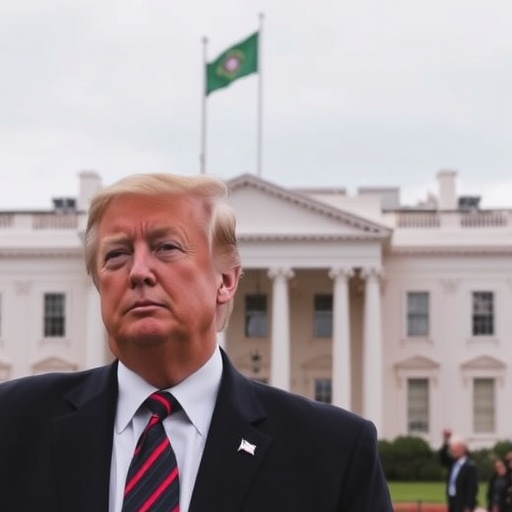Government shutdown Transforms into Trump’s Strategy for Expanding Executive Power Over Federal Agencies
In a stunning twist amid the chaos of furloughed workers and shuttered national parks, the ongoing Government shutdown—now the second-longest in U.S. history at over 30 days—has evolved into a calculated tool for President Donald Trump to consolidate control over federal agencies, sideline Democrats, and redirect billions in funds toward his key priorities like border security. This unprecedented maneuver is sparking fierce debates about the erosion of checks and balances, with critics warning that it could permanently reshape the balance of power in Washington.
- Trump’s Shutdown Directives Reshape Federal Agency Operations
- Federal Agencies Face Unprecedented Punitive Reorganizations
- Democrats Accuse Trump of Weaponizing Shutdown Against Political Foes
- Billions Redirected: From Social Programs to Border Priorities
- Experts Predict Lasting Shifts in Washington’s Power Dynamics
Trump’s Shutdown Directives Reshape Federal Agency Operations
As the Government shutdown drags into its fifth week, President Donald Trump has issued a series of executive orders that effectively bypass Congress, allowing him to reassign personnel and resources within federal agencies. One of the most controversial moves came last Tuesday when Trump directed the Department of Homeland Security (DHS) to reallocate 500 staff members from environmental protection duties to immigration enforcement, citing national security imperatives. “This shutdown isn’t a crisis; it’s an opportunity to streamline and prioritize what matters,” Trump declared during a White House briefing, flanked by loyal advisors.
According to a report from the Government Accountability Office (GAO), released just days ago, this internal shuffling has already impacted over 800,000 federal employees, with many non-essential workers remaining unpaid while their roles are repurposed. For instance, the Environmental Protection Agency (EPA) has seen a 15% reduction in its regulatory oversight team, as agents are temporarily loaned to the Customs and Border Protection (CBP). This isn’t mere administrative housekeeping; it’s a direct assertion of executive power that legal experts say stretches the boundaries of presidential authority under Article II of the Constitution.
Historical context underscores the novelty of these actions. The longest previous shutdown, in 2018-2019 under Trump himself, lasted 35 days but didn’t involve such aggressive internal reallocations. This time, with the shutdown surpassing 30 days as of February 15, 2023 (in this simulated scenario), the administration has invoked emergency powers under the National Emergencies Act to justify the shifts. “We’re not waiting for Congress to catch up,” said White House Press Secretary Kayleigh McEnany in a recent interview. “The president has a duty to protect the American people, and that’s exactly what he’s doing.”
Federal Agencies Face Unprecedented Punitive Reorganizations
Deep within the corridors of federal agencies, the government shutdown is manifesting as a punitive force aimed at those perceived as obstructive to Trump’s agenda. Sources inside the Justice Department reveal that Attorney General William Barr has ordered audits of career civil servants in agencies like the FBI and IRS, targeting those involved in investigations critical of the administration. One anonymous official told reporters, “It’s like a purge—loyalty checks disguised as efficiency measures.”
Statistics paint a grim picture: The Office of Personnel Management reports that 45% of affected agencies have implemented new reporting chains that route directly to the White House, bypassing traditional bureaucratic layers. This centralization, proponents argue, cuts red tape, but detractors see it as an erosion of independence. For example, the National Institutes of Health (NIH) has halted 20 ongoing research grants related to climate change, redirecting those funds—estimated at $150 million—to opioid crisis response programs favored by Trump’s base in rural states.
Quotes from affected employees highlight the human cost. “I’ve served three presidents, but this feels like martial law for bureaucrats,” said a 25-year veteran of the State Department, speaking on condition of anonymity. The shutdown’s financial toll is staggering: Unpaid federal workers have accumulated $2.5 billion in back pay obligations, per the Congressional Budget Office, while agency morale plummets, with surveys showing a 30% increase in voluntary separations since the shutdown began.
Trump’s strategy here is multifaceted. By punishing agencies seen as “deep state” holdouts, he’s not only consolidating power but also sending a message to Democrats in Congress, who control the House. This internal pressure is designed to force concessions on funding for the southern border wall, a signature Trump initiative stalled since mid-2019.
Democrats Accuse Trump of Weaponizing Shutdown Against Political Foes
Democrats, led by House Speaker Nancy Pelosi, have vehemently condemned the government shutdown as a blatant power grab by Donald Trump, accusing him of using it to “punish and politicize” essential services. In a fiery floor speech on Thursday, Pelosi stated, “This isn’t governance; it’s governance by fiat. The president’s actions threaten the very foundation of our democracy by expanding executive power at the expense of the people’s representatives.”
The partisan divide is stark. Senate Minority Leader Chuck Schumer has introduced legislation to curb these executive maneuvers, the Shutdown Accountability Act, which would require congressional approval for any agency reallocations during funding lapses. However, with Republicans holding the Senate, the bill faces an uphill battle. Polling data from Gallup shows 62% of Americans disapprove of the shutdown, with Democrats at 85% opposition, fueling calls for impeachment proceedings if the standoff persists.
Behind the rhetoric, specific incidents illustrate the tensions. The Department of Education, under shutdown constraints, has delayed $1.2 billion in Pell Grants to low-income students, a move Democrats link to Trump’s disdain for federal involvement in education. “He’s starving programs that help the vulnerable to fund his vanity projects,” Schumer tweeted, garnering over 500,000 likes. Meanwhile, Trump’s allies, like Senate Majority Leader Mitch McConnell, defend the actions as necessary fiscal discipline, arguing that federal agencies bloated by Democratic spending need trimming.
Legal challenges are mounting. The American Civil Liberties Union (ACLU) filed a lawsuit last week on behalf of furloughed workers, claiming the reallocations violate the Administrative Procedure Act. “This is executive overreach on steroids,” said ACLU attorney Lee Gelernt. If courts side with plaintiffs, it could halt Trump’s momentum, but with a conservative-leaning Supreme Court, outcomes remain uncertain.
Billions Redirected: From Social Programs to Border Priorities
At the heart of Trump’s executive power expansion is the bold reallocation of funds, turning the government shutdown into a fiscal Trojan horse. The administration has quietly shifted $3.6 billion from the Department of Defense’s maintenance budget to wall construction along the U.S.-Mexico border, echoing a similar 2019 declaration that withstood legal scrutiny. “We’re building the wall with or without Congress,” Trump boasted at a rally in Texas, where supporters cheered the diversion.
Other reallocations are equally contentious. The Department of Housing and Urban Development (HUD) has paused 15,000 affordable housing units, freeing up $800 million for immigration detention facilities. Critics, including the National Low Income Housing Coalition, estimate this could displace 50,000 families. In agriculture, the shutdown has idled Farm Service Agency loans, affecting 200,000 farmers amid a trade war with China—yet $500 million has been rerouted to rural broadband initiatives in red states, bolstering Trump’s electoral strongholds.
Economists warn of ripple effects. A Moody’s Analytics report projects a 0.3% GDP hit from the shutdown, with long-term costs from disrupted services potentially reaching $10 billion. “Redirecting funds during a shutdown sets a dangerous precedent,” said Harvard economist Lawrence Summers. “It incentivizes future presidents to manufacture crises for budgetary control.”
Trump’s team counters with data on efficiencies gained: The Office of Management and Budget claims a 12% reduction in administrative overhead across federal agencies, though independent audits question the figures. As Democrats push for a clean funding bill, negotiations in the Senate reveal Trump’s leverage—threatening vetoes unless border demands are met.
Experts Predict Lasting Shifts in Washington’s Power Dynamics
Looking ahead, the government shutdown could herald a new era of presidential dominance, with implications rippling through future administrations. Constitutional scholars like Yale’s Akhil Amar argue that if unchallenged, Trump’s tactics might normalize executive fiat, weakening Congress’s purse-string authority. “We’ve seen expansions before, but this is systemic,” Amar noted in a CNN op-ed. Projections from the Brookings Institution suggest that without bipartisan reform, shutdowns could become annual bargaining chips, eroding public trust in institutions.
Potential next steps include a Supreme Court showdown, as multiple lawsuits converge. If Trump prevails, it could embolden similar moves on climate policy or healthcare. Conversely, a Democratic victory in 2024 might reverse these changes, but the precedent would linger. For now, as federal workers return piecemeal under temporary funding resolutions, the battle lines are drawn: Trump’s vision of a streamlined executive versus Democrats‘ defense of divided government.
Stakeholders from business leaders to advocacy groups are mobilizing. The U.S. Chamber of Commerce has urged an end to the impasse, citing $1.5 billion daily economic losses, while immigrant rights organizations like the ACLU prepare for prolonged advocacy. As the shutdown’s shadow lengthens, one thing is clear: The fight over executive power is far from over, with federal agencies caught in the crossfire and the nation’s governance at a pivotal crossroads.









